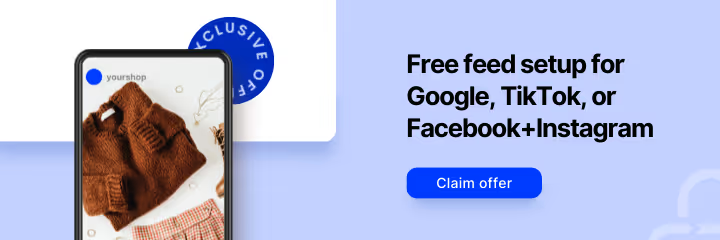Attention spans are short and competition is fierce.
Instagram is a powerful tool to market products and drive sales. But simply posting eye-catching lifestyle photos is no longer enough. To truly capitalize on Instagram's potential, advanced sellers are leveraging the platform's most innovative feature: Product Tags.
Product Tags are not just another Instagram gimmick; they are a direct line from your posts to your profits. By allowing you to tag products directly in your content, Product Tags streamline the customer journey, turning casual browsers into committed buyers with just a few taps. No more clunky links in bios, no more frustrating redirects to external websites. Product Tags bring the shopping experience directly to your customers, right where they are already engaged and primed to purchase.
But the benefits of Product Tags go beyond just convenience. When used strategically, they can skyrocket your visibility, boost your engagement, and ultimately, drive sales.
In this guide, we'll show you exactly how to do it. We'll dive deep into the mechanics of Product Tags, explore advanced tagging strategies, and equip you with the tools and knowledge you need to tap into this powerful Instagram feature.

What is Product Tagging in Instagram?
Instagram product tagging is a feature that allows businesses to tag products directly in their posts, stories, and reels.
Product tags link to the seller’s Instagram Shop. More specifically, they link to the product page within the Shop. This integration turns Instagram content into interactive shopping experiences that enable users to discover, learn about, and buy your product all in one sitting.
Why Instagram Product Tagging is Crucial for Ecommerce
Tagging products in posts, stories, and reels significantly enhances their visibility. Products tagged in content are not limited to your followers; they can also appear in the feeds and explore pages of users who engage with similar content. This broader reach introduces your products to potential customers who are already interested in similar items. For example, a fashion retailer tagging a new collection in a post can reach users exploring fashion content, thereby increasing the chances of attracting new followers and customers.
Product tags simplify the shopping process by allowing users to view product details and complete purchases directly within the Instagram app. This reduces the friction associated with traditional online shopping methods, such as clicking on a link in a bio or being redirected to an external website. By keeping users within the app, the purchasing process becomes more intuitive and immediate, enhancing the overall shopping experience. For instance, a beauty brand tagging its skincare products in a reel allows viewers to tap on the product tags, view details, and purchase without leaving the Instagram app. This convenience can lead to higher engagement and sales.
[See how Meta Checkout further simplifies this process]
Simplifying the purchasing process is crucial for increasing conversion rates. Each additional step in the traditional online shopping journey (such as multiple page loads or redirects) can increase the likelihood of cart abandonment. By reducing these steps, Instagram product tagging makes it easier for users to complete their purchases. Research shows that minimizing friction in the buying process can significantly enhance conversion rates, as customers are more likely to follow through with their purchases when the process is straightforward and convenient. An electronics retailer tagging limited-time offers in their posts can capitalize on impulse purchases. By providing a direct path to purchase within Instagram, they can reduce the likelihood of losing customers to the friction of external redirects.
Transforming Content into Interactive Shopping Experiences
Product tags make your posts, stories, and reels shoppable, engaging users directly within their feed. This turns passive browsing into active shopping, making the shopping experience more immediate and engaging. By integrating shopping features directly into social content, Product Tags bridge the gap between discovery and purchase. This keeps potential customers within the Instagram ecosystem, streamlining their path to purchase and enhancing their overall experience.
Understanding these benefits can help you effectively implement Instagram product tagging to boost your ecommerce strategy. Next, let's explore how you can leverage this feature effectively.

Instagram Product Tagging: Steps and Strategies

Tagging products in posts and videos is similar to tagging people. Follow the steps below to tag your products on Instagram.
If you encounter issues like products not showing up in tags, it could be because your product catalog is not properly synced to Meta Commerce Manager or because your products may not be approved by Instagram Shopping.
Tagging Products in Photos and Videos:

- Create a Post:
- Open the Instagram app and tap the "+" icon to create a new post.
- Choose a photo or video from your gallery or capture new content.
- Tag Products:
- After editing your photo or video, tap “Tag Products.”
- Tap on the area of the photo or video where you want to add the product tag.
- Search for the product in your catalog and select it.
- Final Touches:
- Complete your caption and any additional tags or locations.
- Tap “Share” to publish your post.
Tips for Tagged Photos and Videos:
- Visibility: Ensure product tags are placed prominently without obstructing the view of the product. Avoid placing tags in the corners where they might be missed.
- Relevance: Only tag products that are clearly visible and relevant to the content.
Tagging Products in Stories:
- Create a Story:
- Swipe right from your Instagram home feed or tap your profile picture to add to your story.
- Capture a photo or video or select one from your gallery.
- Add Product Stickers:
- Tap the sticker icon at the top of the screen.
- Select the “Product” sticker.
- Search for the product in your catalog and select it.
- Placement:
- Position the product sticker on your story content. You can resize and move it as needed.
- Publish:
- Tap “Your Story” to publish.
Tips for Tagged Stories:
- Engagement: Use interactive elements like polls or questions alongside product stickers to engage viewers.
- Aesthetics: Ensure the sticker placement aligns with the overall aesthetic of the story. Place stickers where they complement the visual flow.
Tagging Products in Reels:
- Create a Reel:
- Tap the camera icon and select “Reels” at the bottom.
- Capture a series of video clips or upload from your gallery.
- Add Product Tags:
- Tap the “Tag Products” option before posting.
- Search for and select the products you want to tag.
- Finalize and Publish:
- Add effects, music, or text as needed.
- Tap “Share” to publish your reel.
Tips Tagged for Reels:
- Engagement: Use trending music and effects to make your reels more engaging and discoverable.
- Clarity: Ensure product tags are placed clearly so viewers can easily find and click on them.
Addressing Common Issues when Tagging Products
Issue: Products Not Showing Up in Tags:
Solution: Ensure that your product catalog is properly synced and all products are approved by Instagram Shopping. Regularly update your product listings to avoid discrepancies.
Issue: Low Engagement on Tagged Posts:
Solution: Use high-quality images and engaging captions. Experiment with different types of content, such as videos, stories, and reels, to see what resonates most with your audience.
Issue: Compliance and Policy Violations:
Solution: Familiarize yourself with Instagram’s commerce policies and ensure all product listings comply. Regularly review policy updates to stay compliant.
Advanced Product Tagging Strategies for Maximum Impact
).webp)
To fully leverage Instagram product tagging, you’ll want to go beyond the basics. The strategies below enhance visibility, engagement, and conversions. This section will cover best practices and sophisticated tactics to help you get the most out of Instagram product tagging.
Enhanced Tagging Techniques
- Tag multiple products in a single post where relevant. This provides more shopping options to your audience and increases the likelihood of conversions.
- Ensure each tag is clearly associated with the respective product to avoid confusion.
- Use product tags to promote limited-time offers, exclusive launches, or special discounts. Creating a sense of urgency can drive quick sales and increase engagement.
- Make tagged products stand out by pairing them with eye-catching visuals and compelling captions.
Tag Relevant Accounts:
- Tag complementary brands, relevant influencers, and feature accounts in your posts. This can increase the chances of your content being shared and discovered by new audiences.
Leveraging User-Generated Content (UGC)
- Invite your customers to share photos and videos of them using your products. Feature this UGC in your own posts and tag the products, which builds trust and authenticity.
- Run campaigns or contests that encourage UGC, offering incentives for the best posts.
- Identify loyal customers and brand advocates to create content that features your products. Their authentic endorsements can be more persuasive than traditional advertising.
- Provide guidelines and support to ensure the UGC aligns with your brand’s aesthetic and messaging.
Content Creators and Influencer Partnerships
- Choose influencers whose audience closely matches your target market. Their recommendations will carry more weight and be more effective in driving sales.
- Ensure the influencers’ style and values align with your brand to maintain authenticity.
- Work with influencers to create content that integrates your products naturally into their lifestyle. This can include product reviews, tutorials, or day-in-the-life videos.
- Use product tags in these collaborative posts to make it easy for the influencers’ followers to shop directly from the content.
Analyzing Performance and Adjusting Strategies
- Regularly analyze metrics such as likes, comments, shares, and saves to understand what type of content resonates most with your audience.
- Use these insights to refine your content strategy, focusing on the types of posts and tags that drive the most engagement and sales.
- Be flexible and willing to adjust your strategies based on performance data. Experiment with different types of content, posting times, and tagging techniques to see what works best.
- Continuously optimize your approach to ensure you are maximizing the benefits of Instagram product tagging.
Checklist: Product Tagging Eligibility and Setup
.webp)
Meta has specific requirements for setting up product tagging on Instagram. Meeting these criteria is the first step. Follow this checklist to ensure your account is eligible and properly set up so you can start tagging and selling products on Instagram Shopping.
1. Convert to a Business or Creator Account
Steps to Convert:
- Go to Settings:
- Open the Instagram app and go to your profile.
- Tap the three horizontal lines in the top-right corner and select "Settings."
- Account Type:
- Tap "Account."
- Select "Switch to Professional Account."
- Choose either "Business" or "Creator" based on your needs and follow the prompts to complete the setup.
Common Issues:
- Missing Features: Ensure you have the latest version of the Instagram app to access all features.
- Privacy Settings: Business accounts must be public. Ensure your account is not set to private.
2. Set Up and Connect a Facebook Catalog
Steps to Set Up:
- Access Commerce Manager:
- Go to Facebook Commerce Manager at Facebook Commerce Manager.
- Select "Get Started."
- Create a Catalog:
- In Commerce Manager, select “Catalogs” and click “Create Catalog.”
- Choose your catalog type (e.g., Ecommerce) and click “Next.”
- Add Products to the Catalog:
- You can add products manually, use a data feed, or integrate with your ecommerce platform (e.g., Shopify, WooCommerce).
- Follow the prompts to upload your product information.
- Connect Catalog to Instagram:
- Go to your Instagram profile, tap the three horizontal lines, select “Settings,” then “Business,” and “Shopping.”
- Select the catalog you want to connect and tap “Done.”
Common Issues:
- Catalog Syncing: Ensure your product information is accurate and up-to-date. Sync issues can arise if there are discrepancies.
- Account Permissions: Make sure you have the necessary permissions on both Facebook and Instagram to manage catalogs.
3. Submit Your Account for Instagram Shopping Approval
Steps to Submit:
- Review Commerce Eligibility Requirements:
- Ensure your account complies with Instagram’s Commerce Eligibility Requirements.
- Account Review:
- Go to your Instagram profile, tap the three horizontal lines, select “Settings,” then “Business,” and “Shopping.”
- Follow the prompts to submit your account for review.
- Await Approval:
- The review process can take a few days. You will be notified in your Instagram notifications once approved.
Common Issues:
- Approval Delays: Ensure all account and catalog information is accurate to avoid delays. If your account is not approved, check for any compliance issues and reapply.
- Verification: Make sure your business information is complete and verified on Facebook, as incomplete information can lead to rejection.
Troubleshooting Common Issues
Catalog Sync Errors
Regularly update your product listings in Facebook Commerce Manager to avoid sync issues. Integrating with ecommerce platforms can automate this process, ensuring accuracy and efficiency. GoDataFeed simplifies using Instagram as a sales channel by seamlessly integrating your catalog with Meta Commerce Manager. Our Instagram feed template optimizes your products for shopping features, and our robust API supports Meta Checkout, a necessity for Shops. Remember, only sellers using Shops with Meta Checkout can access this feature.
Approval Rejection
If your products are rejected, review the reasons provided by Instagram. Common issues include incomplete descriptions or pricing errors. Correct these and resubmit for approval.
Account Privacy Settings
Ensure your account is set to public, as private accounts cannot use Instagram Shopping.
[Learn more about implementing Meta Checkout here]
Bringing It All Together
Instagram product tagging is more than a feature; it’s a catalyst for ecommerce growth. By making your products easily shoppable, you shorten the distance in your customer journey and greatly improve the chances of engagement.
Start tagging products to turn your posts into effective sales drivers, and let GoDataFeed handle the setup to ensure a seamless experience.
If you’d like to see more insights about Instagram Shop and how it drives ecommerce growth, check out our free Social Commerce Infographic for valuable statistics and tips.






%20).webp)